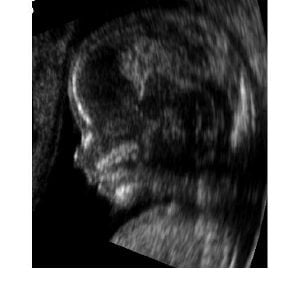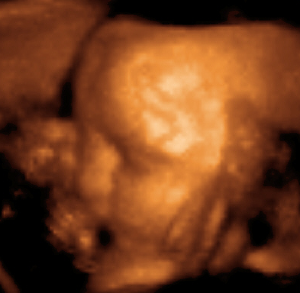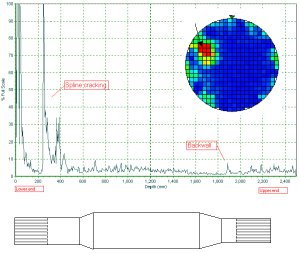Ultrasound
- Not to be confused with Supersonic.
Ultrasound is cyclic sound pressure with a frequency greater than the upper limit of human hearing. Although this limit varies from person to person, it is approximately 20 kilohertz (20,000 hertz) in healthy, young adults and thus, 20 kHz serves as a useful lower limit in describing ultrasound. The production of ultrasound is used in many different fields, typically to penetrate a medium and measure the reflection signature of an object in the medium. The reflection signature can reveal details about the inner structure of the medium. The most well-known application of this technique is its use in sonography to produce pictures of a fetus in the human womb. In addition, some animals can hear ultrasound frequencies, and bats and dolphins use ultrasound for echolocation.
Ability to hear ultrasound
The upper frequency limit in humans (approximately 20 kHz) is caused by the middle ear, which acts as a low-pass filter. Ultrasonic hearing can occur if ultrasound is fed directly into the skull bone and reaches the cochlea without passing through the middle ear. Carefully-designed scientific studies have been performed and confirmed what they call the hypersonic effect - that even without consciously hearing it, high-frequency sound can have a measurable effect on the mind.
It is a fact in psychoacoustics that children can hear some high-pitched sounds that older adults cannot hear, because in humans the upper limit pitch of hearing tends to become lower with age.[1] A cell phone company has used this to create ring signals supposedly only able to be heard by younger humans[2]; but many older people claim to be able to hear it, which is likely given the considerable variation of age-related deterioration in the upper hearing threshold.
Ultrasound and animals
Some animals have an upper frequency limit that is greater than that of the human ear and thus can hear ultrasound.
Bats
Bats use a variety of ultrasonic ranging (echolocation) techniques to detect their prey. They can detect frequencies as high as 100 kHz, although there is some disagreement on the upper limit.[3]
Dogs
Dogs can hear sound at higher frequencies than humans can. A dog whistle exploits this by emitting a high frequency sound to call to a dog. Many dog whistles emit sound in the upper audible range of humans, but some, such as the silent whistle, emit ultrasound at a frequency in the range of 18 kHz to 22 kHz.
Dolphins and whales
It is well known that some whales can hear ultrasound and have their own natural sonar system. Some whales use the ultrasound as a hunting tool (for both detection of prey and as an attack)[4].
Fish
Several types of fish can detect ultrasound. Of the order Clupeiformes, members of the subfamily Alosinae (shad), have been shown to be able to detect sounds up to 180 kHz, while the other subfamilies (e.g. herrings) can hear only up to 4 kHz.[5]
Rodents/insects
Ultrasound generator/speaker systems are sold with claims that they frighten away rodents and insects. Laboratory tests conducted by researchers at Kansas State University gave positive results for products from specific manufacturers. However, controlled tests on some of the systems have shown that rodents quickly learn that the speakers are harmless. Thus there is no clear scientific support for the efficacy of these devices.
Diagnostic sonography
Medical sonography (ultrasonography) is an ultrasound-based diagnostic medical imaging technique used to visualize muscles, tendons, and many internal organs, their size, structure and any pathological lesions with real time tomographic images. It is also used to visualize a fetus during routine and emergency prenatal care. Ultrasound scans are performed by medical health care professionals called sonographers. Obstetric sonography is commonly used during pregnancy. Ultrasound has been used to image the human body for at least 50 years. It is one of the most widely used diagnostic tools in modern medicine. The technology is relatively inexpensive and portable, especially when compared with modalities such as magnetic resonance imaging (MRI) and computed tomography (CT). As currently applied in the medical environment, ultrasound poses no known risks to the patient.[6] Sonography is generally described as a "safe test" because it does not use ionizing radiation, which imposes hazards, such as cancer production and chromosome breakage.
Damaging side effects
However, ultrasonic energy has two potential physiological effects: it enhances inflammatory response; and it can heat soft tissue. Ultrasound energy produces a mechanical pressure wave through soft tissue. This pressure wave may cause microscopic bubbles in living tissues, and distortion of the cell membrane, influencing ion fluxes and intracellular activity. When ultrasound enters the body, it causes molecular friction and heats the tissues slightly. This effect is very minor as normal tissue perfusion dissipates heat. With high intensity, it can also cause small pockets of gas in body fluids or tissues to expand and contract/collapse in a phenomenon called cavitation (this is not known to occur at diagnostic power levels used by modern diagnostic ultrasound units). The long-term effects of tissue heating and cavitation are not known.[7] There are several studies that indicate the harmful side effects on animal fetuses associated with the use of sonography on pregnant mammals. A noteworthy study in 2006 suggests exposure to ultrasound can affect fetal brain development in mice. This misplacement of brain cells during their development is linked to disorders ranging "from mental retardation and childhood epilepsy to developmental dyslexia, autism spectrum disorders and schizophrenia, the researchers said. However, this effect was only detectable after 30 minutes of continuous scanning.[8] A typical fetal scan, including evaluation for fetal malformations, typically takes 10-30 minutes.[9] There is no link made yet between the test results on animals, such as mice, and the possible outcome to humans. Widespread clinical use of diagnostic ultrasound testing on humans has not been done for ethical reasons. The possibility exists that biological effects may be identified in the future, currently most doctors feel that based on available information the benefits to patients outweigh the risks.[10] Obstetric ultrasound can be used to identify many conditions that would be harmful to the mother and the baby. For this reason many health care professionals consider that the risk of leaving these conditions undiagnosed is much greater than the very small risk, if any, associated with undergoing the scan. According to Cochrane review, routine ultrasound in early pregnancy (less than 24 weeks) appears to enable better gestational age assessment, earlier detection of multiple pregnancies and earlier detection of clinically unsuspected fetal malformation at a time when termination of pregnancy is possible.[11]
Sonography is used routinely in obstetric appointments during pregnancy, but the FDA discourages its use for non-medical purposes such as fetal keepsake videos and photos, even though it is the same technology used in hospitals.
Obstetric ultrasound is primarily used to:
- Date the pregnancy (gestational age)
- Confirm fetal viability
- Determine location of fetus, intrauterine vs. ectopic
- Check the location of the placenta in relation to the cervix
- Check for the number of fetuses (multiple pregnancy)
- Check for major physical abnormalities.
- Assess fetal growth (for evidence of intrauterine growth restriction (IUGR))
- Check for fetal movement and heartbeat.
- Determine the sex of the baby
Unfortunately, results are occasionally wrong, producing a false positive (the Cochrane Collaboration is a relevant effort to improve the reliability of health care trials). False detection may result in patients being warned of birth defects when no such defect exists. Sex determination is only accurate after 12 weeks gestation [Ultrasound in Obstetrics and Gynecology, 1999]. When balancing risk and reward, there are recommendations to avoid the use of routine ultrasound for low risk pregnancies [ACOG]. In many countries ultrasound is used routinely in the management of all pregnancies.
According to the European Committee of Medical Ultrasound Safety (ECMUS) "Ultrasonic examinations should only be performed by competent personnel who are trained and updated in safety matters. Ultrasound produces heating, pressure changes and mechanical disturbances in tissue. Diagnostic levels of ultrasound can produce temperature rises that are hazardous to sensitive organs and the embryo/fetus. Biological effects of non-thermal origin have been reported in animals but, to date, no such effects have been demonstrated in humans, except when a microbubble contrast agent is present."
A study on rodent fetus brains that are exposed to ultrasound showed signs of damage. Speculation on human fetuses can be in a range of no significant complications to a variety of mental and brain disorders. The study shows that rodent brain cells failed to grow to their proper position and remained scattered in incorrect parts of the brain. The conditions of this experiment are different from typical fetal scanning because of the long dwell times. [National Institute of Neurological Disorders; Proceedings of the National Academy of Sciences]. Care should be taken to use low power settings and avoid pulsed wave scanning of the fetal brain unless specifically indicated in high risk pregnancies.
It should be noted that obstetrics is not the only use of ultrasound. Soft tissue imaging of many other parts of the body is conducted with ultrasound. Other scans routinely conducted are cardiac, renal, liver and gallbladder (hepatic). Other common applications include musculo-skeletal imaging of muscles, ligaments and tendons, ophthalmic ultrasound (eye) scans and superficial structures such as testicle, thyroid, salivary glands and lymph nodes. Because of the real time nature of ultrasound, it is often used to guide interventional procedures such as fine needle aspiration FNA or biopsy of masses for cytology or histology testing in the breast, thyroid, liver, kidney, lymph nodes, muscles and joints.
Ultrasound scanners using pulsed wave and color Doppler are used to visualize arteries and veins.
Figures released for the period 2005-2006 by UK Government (Department of Health) show that non-obstetric ultrasound examinations contributed to more than 65 percent of the total number of ultrasound scans conducted.
Biomedical ultrasonic applications
Ultrasound also has therapeutic applications, which can be highly beneficial when used with dosage precautions:[12]
- According to RadiologyInfo,[13] ultrasounds are useful in the detection of pelvic abnormalities and can involve techniques known as abdominal (transabdominal) ultrasound, vaginal (transvaginal or endovaginal) ultrasound in women, and also rectal (transrectal) ultrasound in men.
- Treating benign and malignant tumors and other disorders via a process known as high intensity focused ultrasound (HIFU), also called focused ultrasound surgery (FUS). In this procedure, a generally lower frequencies than medical diagnostic ultrasound is used (250-2000 kHz), but significantly higher time-averaged intensities. The treatment is often guided by magnetic resonance imaging (MRI)—this is called Magnetic resonance-guided focused ultrasound (MRgFUS). Delivering chemotherapy to brain cancer cells and various drugs to other tissues is called acoustic targeted drug delivery (ATDD).[14] These procedures generally use high frequency ultrasound (1-10 MHz) and a range of intensities (0-20 watts/cm2). The acoustic energy is focused on the tissue of interest to agitate its matrix and make it more permeable for therapeutic drugs.[15][16] (ATDD).
- Therapeutic ultrasound, a technique that uses more powerful ultrasound sources to generate local heating in tissue: Used in occupational therapy, physical therapy, athletic training, and cancer treatment.
- Cleaning teeth in dental hygiene.
- Focused ultrasound sources may be used for cataract treatment by phacoemulsification.
- Additional physiological effects of low-intensity ultrasound have recently been discovered, e.g. the ability to stimulate bone-growth and its potential to disrupt the blood-brain barrier for drug delivery.
- Ultrasound is essential to the procedures of ultrasound-guided sclerotherapy and endovenous laser treatment for the non-surgical treatment of varicose veins.
- Ultrasound-assisted lipectomy is lipectomy assisted by ultrasound. Liposuction can also be assisted by ultrasound.
- Doppler ultrasound is being tested for use in aiding tissue plasminogen activator treatment in stroke sufferers in the procedure called ultrasound-enhanced systemic thrombolysis.
- Low intensity pulsed ultrasound is used for therapeutic tooth and bone regeneration.
- Ultrasound can also be used for elastography. This can be useful in medical diagnoses, as elasticity can discern healthy from unhealthy tissue for specific organs/growths. In some cases unhealthy tissue may have a lower system Q, meaning that the system acts more like a large heavy spring as compared to higher values of system Q (healthy tissue) that respond to higher forcing frequencies. Ultrasonic elastography is different from conventional ultrasound, as a transceiver (pair) and a transmitter are used instead of only a transceiver. One transducer (a single element {or array of elements} acts as both the transmitter and receiver to image the region of interest over time. The extra transmitter is a very low frequency transmitter, and perturbs the system so the unhealthy tissue oscillates at a low frequency and the healthy tissue does not. The transceiver, which operates at a high frequency (typically MHz) then measures the displacement of the unhealthy tissue (oscillating at a much lower frequency). The movement of the slowly oscillating tissue is used to determine the elasticity of the material, which can then be used to distinguish healthy tissue from the unhealthy tissue.
- Ultrasound has been shown to act synergistically with antibiotics in bacterial cell killing.
- Ultrasound has been postulated to allow thicker eukaryotic cell tissue cultures by promoting nutrient penetration.Scientific Article
- Ultrasound in the low MHz range in the form of standing waves is an emerging tool for contactless separation, concentration and manipulation of microparticles and biological cells. The basis is the acoustic radiation force, a non-linear effect which causes particles to be attracted to either the nodes or anti-nodes of the standing wave depending on the acoustic contrast factor, which is a function of the sound velocities and densities of the particle and of the medium in which the particle is immersed.
Industrial ultrasound
Ultrasonic testing is a type of nondestructive testing commonly used to find flaws in materials and to measure the thickness of objects. Frequencies of 2 to 10 MHz are common but for special purposes other frequencies are used. Inspection may be manual or automated and is an essential part of modern manufacturing processes. Most metals can be inspected as well as plastics and aerospace composites. Lower frequency ultrasound (50 kHz to 500 kHz) can also be used to inspect less dense materials such as wood, concrete and cement.
Ultrasound can also be used for heat transfer in liquids.[17]
Researchers recently employed ultrasound in dry corn milling plant to enhance ethanol production.[18]
Ultrasonic cleaning
Ultrasonic cleaners, sometimes mistakenly called supersonic cleaners, are used at frequencies from 20-40 kHz for jewelry, lenses and other optical parts, watches, dental instruments, surgical instruments, diving regulators and industrial parts. An ultrasonic cleaner works mostly by energy released from the collapse of millions of microscopic cavitations near the dirty surface. The bubbles made by cavitation collapse forming tiny jets directed at the surface. Home ultrasonic cleaners are available and cost about US $60 or more.
Ultrasonic humidifier
The ultrasonic humidifier, one type of nebulizer (a device that creates a very fine spray), is a popular type of humidifier. It works by vibrating a metal plate at ultrasonic frequencies to nebulize (sometimes incorrectly called "atomize") the water. Because the water is not heated for evaporation, it produces a cool mist. The ultrasonic pressure waves nebulize not only the water but also materials in the water including calcium, other minerals, viruses, fungi, bacteria[19], and other impurities. Illness caused by impurities that reside in a humidifier's reservoir fall under the heading of "Humidifier Fever."
Ultrasound Identification (USID)
Ultrasound Identification (USID) is a Real Time Locating System (RTLS) or Indoor Positioning System (IPS) technology used to automatically track and identify the location of objects in real time using simple, inexpensive nodes (badges/tags) attached to or embedded in objects and devices, which then transmit an ultrasound signal to communicate their location to microphone sensors.
Sonochemistry
Power ultrasound in the 20-100 kHz range is used in chemistry. The ultrasound does not interact directly with molecules to induce the chemical change, as its typical wavelength (in the millimeter range) is too long compared to the molecules. Instead:
- It causes cavitation which causes local extremes of temperature and pressure in the liquid where the reaction happens.
- It breaks up solids and removes passivating layers of inert material to give a larger surface area for the reaction to occur over.
Both of these make the reaction faster.
Ultrasonic disintegration
Some sorts of ultrasound can disintegrate biological cells including bacteria. This has uses in biological science and in killing bacteria in sewage. High power ultrasound at frequency of around 20 kHz produces cavitation that facilitates particle disintegration. Dr. Samir Khanal of Iowa State University employed high power ultrasound to disintegrate corn slurry to enhance liquefaction and saccharification for higher ethanol yield in dry corn milling plants.
See examples:
- Ultrasound pre-treatment of waste activated sludge
- Retooling ethanol industries: integrating ultrasonics into dry corn milling to enhance ethanol yield
- Enhancement of anaerobic sludge digestion by ultrasonic disintegration
Ultrasonic range finding
A common use of ultrasound is in range finding; this use is also called SONAR, (sound navigation and ranging). This works similarly to RADAR (radio detection and ranging): An ultrasonic pulse is generated in a particular direction. If there is an object in the path of this pulse, part or all of the pulse will be reflected back to the transmitter as an echo and can be detected through the receiver path. By measuring the difference in time between the pulse being transmitted and the echo being received, it is possible to determine how far away the object is.
The measured travel time of SONAR pulses in water is strongly dependent on the temperature and the salinity of the water. Ultrasonic ranging is also applied for measurement in air and for short distances. Such method is capable for easily and rapidly measuring the layout of rooms.
Although range finding underwater is performed at both sub-audible and audible frequencies for great distances (1 to several ten kilometers), ultrasonic range finding is used when distances are shorter and the accuracy of the distance measurement is desired to be finer. Ultrasonic measurements may be limited through barrier layers with large salinity, temperature or vortex differentials. Ranging in water varies from about hundreds to thousands of meters, but can be performed with centimeters to meters accuracy.
Other uses
Ultrasound when applied in specific configurations can produce short bursts of light in an exotic phenomenon known as sonoluminescence. This phenomenon is being investigated partly because of the possibility of bubble fusion (a nuclear fusion reaction hypothesized to occur during sonoluminescence).
Recently researchers at the University of Alberta in Canada have successfully used ultrasound to regenerate dental material[20].
Ultrasound is used when characterizing particulates through the technique of ultrasound attenuation spectroscopy or by observing electroacoustic phenomena.
In rheology, an acoustic rheometer relies on the principle of ultrasound. In fluid mechanics, fluid flow can be measured using an ultrasound flow meter.
Ultrasound also plays a role in Sonic weaponry.
Audio can be propagated by modulated ultrasound.
See also
Notes
- ↑ European Journal of Applied Physiology 65(5): 403-408.
- ↑ Paul Vitello, June 12, 2006. A Ring Tone Meant to Fall on Deaf Ears. New York Times. Retrieved September 8, 2008.
- ↑ Juan Cancel. 1998. Frequency of Bat Sonar. The Physics Factbook. Retrieved September 8, 2008.
- ↑ Home Page. Voices in the sea. Retrieved September 8, 2008.
- ↑ DA Mann, et al. 2001. Ultrasound detection by clupeiform fishes. JASA 109(6): 3048-3054.
- ↑ Nicholas J. Hangiandreou, 2003. AAPM/RSNA Physics Tutorial for Residents: Topics in US. Radiographics 23: 1019-1033. Retrieved September 8, 2008.
- ↑ FDA Radiological Health - Ultrasound Imaging. FDA. Retrieved September 8, 2008.
- ↑ Randolph E. Schmid, Associated Press, Ultrasound Can Affect Fetal Brain Development. LiveScience. Retrieved September 8, 2008.
- ↑ Ultrasonographic Screening for Fetal Malformations. obgyn.net. Retrieved September 8, 2008.
- ↑ Patient Information - Ultrasound Safety. AIUM. Retrieved September 8, 2008.
- ↑ Ultrasound for fetal assessment in early pregnancy. The Cochrane Collaboration. Retrieved September 8, 2008.
- ↑ M.H. Rapacholi, 1982. Essentials of Medical Ultrasound: A Practical Introduction to the Principles, Techniques and Biomedical Applications. (Clifton, NJ: Humana Press. ISBN 9780896030282).
- ↑ Ultrasound - Pelvis. Radiology Info. Retrieved September 8, 2008.
- ↑ George Lewis, Jr., and William Olbricht. 2007. Acoustic targeted drug delivery in neurological tissue. The Journal of the Acoustical Society of America. 122(5):3007. Retrieved September 8, 2008.
- ↑ G.K. Lewis, and W. Olbricht. 2007. A phantom feasibility study of acoustic enhanced drug delivery to neurological tissue. IEEE Xplore. Retrieved September 8, 2008.
- ↑ Acoustics and brain cancer. Eurekalert.
- ↑ Milton B. Larson, 1960. Study of the Effects of Ultrasonic Vibrations on Convective Heat Transfer in Liquids. Thesis (Ph. D.)-Dept. of Mechanical Engineering, Stanford University.
- ↑ Aili McConnon, 2006. Using Infrared To See If You're Lit. Business Week. Retrieved September 8, 2008.
- ↑ S. Oie, N. Masumoto, K. Hironaga, A. Koshiro, A. Kamiya. 1992. Microbial contamination by ultrasonic humidifier. Microbios. 72:292-293:161-166. Retrieved September 8, 2008.
- ↑ Dey, Phoebe. 2006. Toothsome research may hold key to repairing dental disasters. ExpressNews - University of Alberta. Retrieved September 8, 2008.
ReferencesISBN links support NWE through referral fees
- Kremkau, Frederick W. 2005. Diagnostic Ultrasound: Principles and Instruments. St. Louis, MO: Elsevier Saunders. ISBN 0721631924.
- Kundu, Tribikram. Ultrasonic nondestructive evaluation : engineering and biological material characterization. Boca Raton, FL: CRC Press, 2004. ISBN 0849314623.
- Rapacholi, M.H. 1982. Essentials of Medical Ultrasound: A Practical Introduction to the Principles, Techniques and Biomedical Applications. Clifton, NJ: Humana Press. ISBN 9780896030282.
- Thomas, Jeanette A., Cynthia Moss, and Marianne Vater. 2004. Echolocation in Bats and Dolphins. Chicago: The University of Chicago Press. ISBN 0226795993.
Credits
New World Encyclopedia writers and editors rewrote and completed the Wikipedia article in accordance with New World Encyclopedia standards. This article abides by terms of the Creative Commons CC-by-sa 3.0 License (CC-by-sa), which may be used and disseminated with proper attribution. Credit is due under the terms of this license that can reference both the New World Encyclopedia contributors and the selfless volunteer contributors of the Wikimedia Foundation. To cite this article click here for a list of acceptable citing formats.The history of earlier contributions by wikipedians is accessible to researchers here:
The history of this article since it was imported to New World Encyclopedia:
Note: Some restrictions may apply to use of individual images which are separately licensed.




